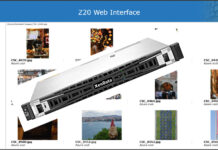Analysis: Right now, the two dominant storage demand and development drivers are cyber-resilience and security on the one hand, and AI training and inference on the other.
The IT storage picture at the start of 2025 is vibrant and healthy with developments ongoing at all levels of the storage stack, driven by demands for more memory, more and larger SSDs, higher-capacity disk drives, better data serving to GPUs, and preparation for AI-driven analysis. We also see improved data protection and security and the ongoing promotion of object storage to higher-performing access for AI training and inference.
Let’s step back for a second and ask what actually constitutes IT storage and what it is for. The second question is easier to answer. Storage exists to supply data for applications running in servers or other host processors and to store the data these applications produce. Everything that uses stored data is an application in this sense.
We can envisage IT storage as a stack of layers, from basic recording media types at the lowest level and running up through devices that package this media into drives, next-level devices that package these drives into usable hardware systems, such as SANs and filers, the software that controls these systems, and then upper-level software that presents storage as a protocol and API-accessed facility to applications.
That includes SANs with block-level data access, files with file-level access, and object storage. But the applications could also be transactional or analytic databases that present their storage as a protocol-accessed facility to customer relationship management software systems, or AI-driven fraud detection analytic apps using a data warehouse.
Data can be separated into primary data, used for databases, and secondary data – copies of one sort or another, used for protection against primary data loss or corruption. There is a third level: Tertiary or archive data used to keep reference data for the long-term.
We can try and encapsulate all these ideas in a storage layers diagram:

It has two sidebars: a business model one on the left, and backup to cyber resilience on the right. These apply at multiple levels in the storage stack and don’t constitute a single layer.
We can use this diagram to place technologies and suppliers generally, not precisely, in the stack and see how they relate to each other and evolve over time. Here’s an example showing some data management suppliers:

As you move up the stack from bottom to top, the number of startup suppliers generally increases, as does their funding. At the bottom level, the NAND, disk, and tape media suppliers haven’t changed much at all for several years after earlier supplier consolidations. For example, there are the three disk drive suppliers – Seagate, Toshiba, and Western Digital. Over 90 percent of DRAM is supplied by Micron, Samsung, and SK hynix, with Nanya and Winbond having a niche market presence.
However, there is startup activity in the DRAM connectivity area, where the CXL concept of connected external memory has encouraged the development of CXL hardware and software suppliers, such as Panmnesia and UniFabriX. There are also 3D DRAM developments, witness startup Neo Semiconductor.
NAND supply has been pretty stable, until Intel sold off its NAND division as Solidigm to SK hynix, with Kioxia, Micron, Samsung, SK hynix/Solidigm, Western Digital, and China’s YMTC. Kioxia has just gone public. Western Digital is splitting into separate disk drive and NAND/SSD (SanDisk?) businesses this year, and there may be some supplier consolidation activity here.
The hardware array layer was dominated by block and file protocol incumbents in the 2000-2010 era, with Dell, Hitachi Vantara, HPE, IBM, and NetApp. We saw the entry of Pure Storage in 2009, Infinidat in 2010, StorONE in 2011, and VAST Data in 2016. Since then, no new significant storage array startups have emerged. VAST’s DASE architecture has, however, influenced HPE, caused NetApp to initiate an ONTAP development project, and coincided with Quantum’s Myriad Storage operating system development.
The enterprise filer area had seen relatively little development, with Dell and NetApp dominating. But Qumulo entered this market in 2012, WEKA in 2013, and VAST in 2016. HPC parallel file system players include incumbents DDN (Lustre), IBM with Storage Scale, and Panasas, now renamed VDURA. Intel’s DAOS, BeeGFS, and Quobyte are also present here.
There is frantic ongoing development in the data container space, especially in the analytics area, with data warehouses and big data-era Hadoop transitioning to data lakes and lakehouses to include more unstructured data types. Snowflake was founded in 2012, grew like crazy and went public in 2020. Databricks was founded in 2013 and has grown so much that it has raised a mind-boggling $14 billion in VC funding. Some $10 billion of that was raised last year, surely a record storage startup funding amount and providing a high-pressure backdrop to any forthcoming Databricks IPO.
The GenAI large language model boom is driving surging growth in this area, with specialized vector database suppliers appearing like Pinecone, founded in 2019, and Milvus, started up by Zilliz in 2017. Existing data type consolidating players like SingleStore are determined not to be left behind.
Where would we locate CTERA, Egnyte, Nasuni, and Panzura? They would be placed in the protocol layer, under file and in the Cloud-to-edge category as they all supply collaboration facilities. Panzura is moving into the data management area after buying Moonwalk and developing its Symphony offering. Nasuni, with private equity now owning a majority of its business, is moving heavily into AI, as is CTERA.
Where do computational storage suppliers fit? We have both computational drives – ScaleFlux, for example – and computational storage systems, like storage array controllers running containerized application software, hinted at by VAST Data and Dell.
Where are DPUs and SmartNICs situated? There is a DPU-assisted category in the Hardware Type layer, second from the bottom. At one time, there looked to be a separate group of DPU startup suppliers – Pensando and Fungible, for example – but they have all been bought and we now have incumbent suppliers dominating this area: Amazon, AMD (Pensando), Intel, Microsoft with Azure (Fungible), and Nvidia with its BlueField products.
DataCore, in receipt of AI development dollars, is in the StorageOS layer, along with StorPool and Red Hat’s Ceph.
Where are Dell PowerProtect, ExaGrid, ObjectFirst, Quantum DXi, and HPE StoreOnce located? These are all specialized arrays providing target backup appliance functionality.
Cyber-resilience and SaaS are reshaping the backup area as Cohesity, Commvault, Dell, Rubrik, and Veeam tussle to lead the data protection plus security market, with energetically developing players like Druva, HYCU, KeepIt, and others active as well.
We can expect CXL to have more of a presence in 2025, but the two main significant storage market drivers should continue to be AI and cyber-resilience.








